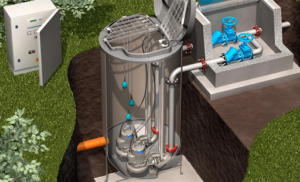
Lift stations and pumps are fairly common in Houston. This is simply due to the topography of the great state of Texas. Anyone who’s driven across the state knows that most of Texas is about as flat as a pancake. The average elevation in the Houston region is 79 ft, and in downtown Houston, it’s only 50 ft. What that means for stormwater is the rain that falls in Houston has a whopping 50 feet of fall in 50 miles. This equates to 1 ft of fall per mile. Healthy drainage occurs at a 2% minimum, meaning 2.4 inches of drop for every 10 ft. As you can see, based on real-world conditions, we can only drop 2 inches every 880 ft! This is why we get flooding during heavy rain events. The water simply can’t move fast enough to Galveston Bay. Because of this lack of elevation change, ditches, and storm sewers throughout the city are fairly shallow. Understanding these limitations is critical in designing a commercial property’s detention pond.
Lift Station Design
Detention requirements in Houston and Harris County are between 0.7 and 1 acre-feet per acre. This is rarely negotiable so must be considered in design. Before a civil engineer can do so he/she needs to know the elevation of the receiving stream, ditch, or storm sewer. With this information, the engineer can design a detention pond that gravity drains to the receiving waters. But sometimes the ditch or storm sewer is so shallow that to gravity drain would require a shallow detention pond so large that it wouldn’t be cost-effective to develop the property, essentially killing the deal. To circumvent this problem, the detention pond can be designed deeper than the surrounding drainage. This kind of design would require the addition of a lift station that pumps the water from the bottom of the pond and discharges it to the receiving ditch or storm sewer system. This approach adds to the detention requirement but may be the only way to make development financially viable.
Lift Station Maintenance
Maintaining pumps and lift stations is part and parcel of ownership. That should be pretty clear. What may not be so clear is who you should call when the system fails. Common sense dictates that since this is a drainage issue you would call a plumber. But plumbers deal mostly with either pressurized potable water supply or gravity drainage of sanitary lines. Rarely do plumbers deal with these large pumps and associated piping, nor do they typically deal with storm drainage. This is why we sometimes see schedule 40 (meant for low pressures) discharge pipes and fittings used instead of schedule 80 (suitable for higher pressures) in lift stations. The start pressure of these pumps is too much for schedule 40 piping and leads to line breaks and fitting failures. So while it seems that since a lift station is a piped ( or plumbed) system, a plumber would be the right guy for the job. Nothing could be farther from the truth. It’s like comparing an auto mechanic to an airplane mechanic. Sure, they both work on engines, but I for one am not flying in a plane repaired by an auto mechanic!
Lift Station Troubleshooting
Next, you may conclude that if the problem seems to be in the control panel you might want to call your electrician. That makes sense in that these systems are always controlled by a series of switches and regulators, all of which are electrical in nature. However, these are highly specialized systems with a combination of mechanical and electrical parts that must work together in order for the system to function properly. So, while an electrician can certainly diagnose any anomalies in the electrical system, and make those repairs, you may find that the system still doesn’t function properly because there are also issues with the pumps or float switches. These mechanical items are outside the scope and training of electricians, so you might end up needing to call out another expensive contractor who is familiar with pumps.
Complimentary Lift Station Assessment
Fortunately, you have a third choice. You could call a specialty contractor who can install, replace, maintain, and manage your lift station and its components. From electrical to mechanical, Stormwater Professionals Group has you covered. We always provide a free diagnosis of the problem as well as cost-effective options for repair or replacement. With no further obligation. We also offer preventive maintenance packages that include a 19-point inspection of the entire system, including pulling pumps and checking all electrical and mechanical components of the system. If the problem is a sanitary, instead of a stormwater, lift station, we can handle that as well. With 24 hr. Emergency services you can rest assured that when your lift station goes down, your business doesn’t have to.
